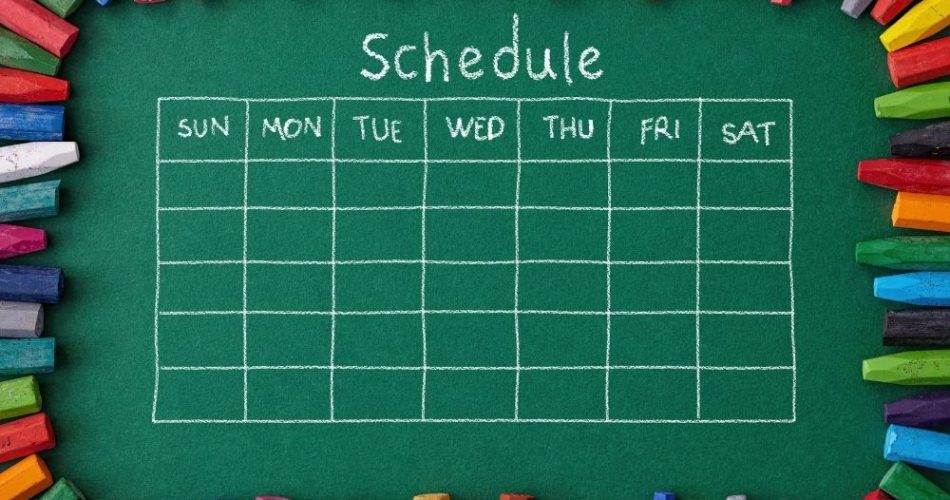So you’ve decided to leap into homeschooling. Now you are the educator in addition to being a mom…you are a homeschool mom. You’ve chosen the best curriculum for your kids, found a local homeschooling support system, and are now ready to plan out a daily homeschool schedule. But how do you plan a daily homeschool schedule? Let’s take it one step-by-step.
Planning a Homeschool Schedule for the Long Term
Before planning a homeschooling routine, families should research and read through their state’s homeschooling laws. Each state is different, but many have a specific number of days or hours that need to be spent in instruction, while other states do not have specific homeschool regulations. The common standard to use for the length of the school year is 180 days. Most curriculum published for homeschooling families is designed for a 36-week school term. This is helpful to a homeschooling family when planning things like the schedule for the year, weekly schedule of lessons, or the daily schedule since homeschool schedules are relatively flexible and can be adjusted according to the need for days off or the need for quiet time in the homeschool day.
Some flexible thumb rules are that a traditional school year generally runs from around Labor Day to the end of May or the beginning of June, based 180-day calendar. However, ‘flexible’ is the keyword when it comes to planning homeschool schedules. Families can set up their homeschooling schedules together, making fun and interesting learning experiences a daily occurrence. Many homeschool families create their yearly school schedule to line up with their county or city’s public school schedule.
Making a Homeschool Schedule
When constructing a weekly homeschool schedule, families need to use flexibility. Between work schedules, co-op meetings, activities, and clubs or organizations students or parents are involved in, in addition to daily family life, effective lesson planning is crucial. Families can create their schedules to serve their situations best. Weekly schedules do not have to be Monday through Friday but can be four days on, one-off, or tweak it to fit a parent’s irregular work week so that they can still get valuable family time.
What About a Block Schedule?
A block schedule can be an option for homeschooling families to consider. This type of schedule allows for extended time for subjects as needed. A family can create the schedule they would like to follow, or that works for the week. An example of a block schedule might be two hours of history in the morning, followed by lunch and play, and then two hours of language arts in the afternoon, with time left for quiet time, work on long-term projects, or time for extra math help or reading.
The homeschool schedule can change or adjust by shuffling the blocks by a week or on an individual basis. Kids like a predictable schedule but also respond well to changing the subjects around. Homeschool families should also ensure that kids are getting time to relax and physical movement opportunities as needed. At least one break period or recess should be scheduled in the morning, one at lunchtime, and one in the afternoon. Children need a regular school routine, with both formal physical activities and time for children to play take a break from their studies.
Creating a Daily Schedule That Works
Deciding what a daily homeschool schedule looks like in your family is for you and your family to decide together. Deciding together gives kids ownership and a stake in what they are learning. However, while a schedule makes sense in concept, it may not always work out exactly how planned. It’s ok. Sometimes the daily schedule may require a tweak — a break may be needed, the mom gets sick, or the kids need a play break or a time for quiet reading.
Creating a daily schedule that is for the whole family may take a while. It may change on a monthly or yearly basis, but it is crucial that homeschoolers craft a routine that children can learn to expect and that can help school learning become more effective for both mom and kids.
When building homeschool schedules, make sure that all of the family’s other daily requirements in mind. This includes housework and chores. Allow time for kids to work independently and for instruction, experiments, activities, math games or time for students to find that they may love to read. This sounds like a lot. It is. However, once a routine has been established, the daily schedule will become a consistent routine.
Be Realistic
Before establishing an everyday homeschool schedule, it’s key for homeschooling families to be realistic when making one that works. How much time do you have to devote to instruction, activities, and help with schoolwork every day? Make sure to include downtime, lunch at the same time as possible, and find time for physical activity and interests outside of school work. So what do some examples of daily schedules look like?
How Many Hours a Day Should You Expect to Homeschool?
A good rule of thumb to estimate how many hours you should expect to allow for instruction and classwork at home is to consider the student’s age and grade level. A school day for a high-schooler will be longer than a school day for a kindergartner. High school homeschoolers can expect to be learning for five or six hours daily. Middle-schoolers may be more like four to five hours per day. Middle and upper elementary school students often spend three to four hours a day on schoolwork. For a younger preschool, kindergarten, first, or second-grade learner, one or two hours is the extent of their ability to focus and remain engaged.
For families with two or more students at home, the day may spread out over many hours…because life happens. Some kids take longer than others to do the same volume of work. Others don’t have much trouble completing assignments and can then choose a quiet activity to work on while working with mom. Just know that one day is invariably different than another.
Outside Group Interactions
Families that participate in homeschool co-ops also may find that meet-up days take up a good chunk of school. Once this routine is more firmly established, one or two changes during the school day are occurrences that students know may happen. The changes and variety throughout the school day help kids become more flexible and handle more stressful situations they may encounter.
Some Daily Schedule Examples
Early Elementary
A sample second-grade schedule can include spelling, reading, writing, a 15-20 minute play break, and lunch. After lunch, other key subjects like history, geography, government, science, and specials, including music, art, computers, or even a foreign language, can be rotated. You can choose to rotate the classes daily or on a week-on/week-off basis. Whatever works for you and your kids is what is best. Be willing to make changes to the routine as needed. This may rarely happen or can happen every year.
Upper Elementary and Middle School Students
For older elementary or middle school students, a block schedule may be a good choice. One example of a middle schooler block schedule may include a block for English Language Arts (ELA)-including reading time, grammar, and writing. A math block should include direct instruction, guided practice, helping the students with sample or practice problems, and independent work. This block can also include opportunities for math games, with both board-type games and online games.
Working on a ‘project’ such as solving a tricky word problem, using measurements to compose and complete math problems, and construction or building sets can all project that older kids can enjoy alongside their younger siblings while working as a team. This can also help encourage team-building. There should also be blocked-off periods for science and social studies. If participating in religious education, this should be considered when designing an older elementary or middle school student’s schedule.

Allowing opportunities for art, music, foreign language, and projects require creative planning but are doable. Outside activities such as sports teams, dance classes, karate, or music lessons should all be planned out, with adequate time included for travel to and from them.
High School Students
For high-schoolers, the school day may look very different. You could find that at first, high-schoolers are anxious to focus on subjects they are more interested in. This can be possible for high school grade level students throughout the year. Core classes in mathematics-including Algebra, Geometry, Trigonometry, Calculus, and others, always need to be part of a schedule. English is generally recommended each year as well. Science, History, Government, Economics, Languages, and other key classes are a key part of almost all homeschool curriculum. Special electives like, art including sculpture, painting, and drawing should be offered. Music or band is an option for art education requirements. Many families also use community resources and classes for kids to participate in.
Make Every Day a Learning Adventure
With so many options available for families who have chosen to educate at home, home learning can be something that both adults and kids can love. Start each morning with adventure in mind—mix activities throughout to keep students engaged. Go on field trips that are both fun and informative. Make art funny by getting messy and creative. Whether watching a film together or conducting science experiments, being homeschoolers definitely has its benefits.




